●
Keep work area free of nonconductive materials, such as ordinary plastic assembly aids and
Styrofoam.
●
Use field service tools, such as cutters, screwdrivers, and vacuums, that are conductive.
Recommended materials and equipment
Materials and equipment that are recommended for use in preventing static electricity include:
●
Antistatic tape
●
Antistatic smocks, aprons, or sleeve protectors
●
Conductive bins and other assembly or soldering aids
●
Conductive foam
●
Conductive tabletop workstations with ground cord of one-megohm ± 10% resistance
●
Static-dissipative table or floor mats with hard tie to ground
●
Field service kits
●
Static awareness labels
●
Wrist straps and footwear straps providing one-megohm ± 10% resistance
●
Material handling packages
●
Conductive plastic bags
●
Conductive plastic tubes
●
Conductive tote boxes
●
Opaque shielding bags
●
Transparent metallized shielding bags
●
Transparent shielding tubes
Tools and software requirements
●
Torx T-15 screwdriver or flathead screwdriver
●
Diagnostics software
Screws
The screws used in the workstation are not interchangeable. They might have standard or metric threads
and might be of different lengths. If an incorrect screw is used during the reassembly process, it can
damage the unit. HP strongly recommends that all screws removed during disassembly be kept with
the removed part, and then returned to their proper locations.
NOTE Metric screws have a black finish. American National (unified) screws have a silver finish.
NOTE As each subassembly is removed from the workstation, place the subassembly away
from the work area to prevent damage.
56 Chapter 4 Removal and replacement procedures ENWW

